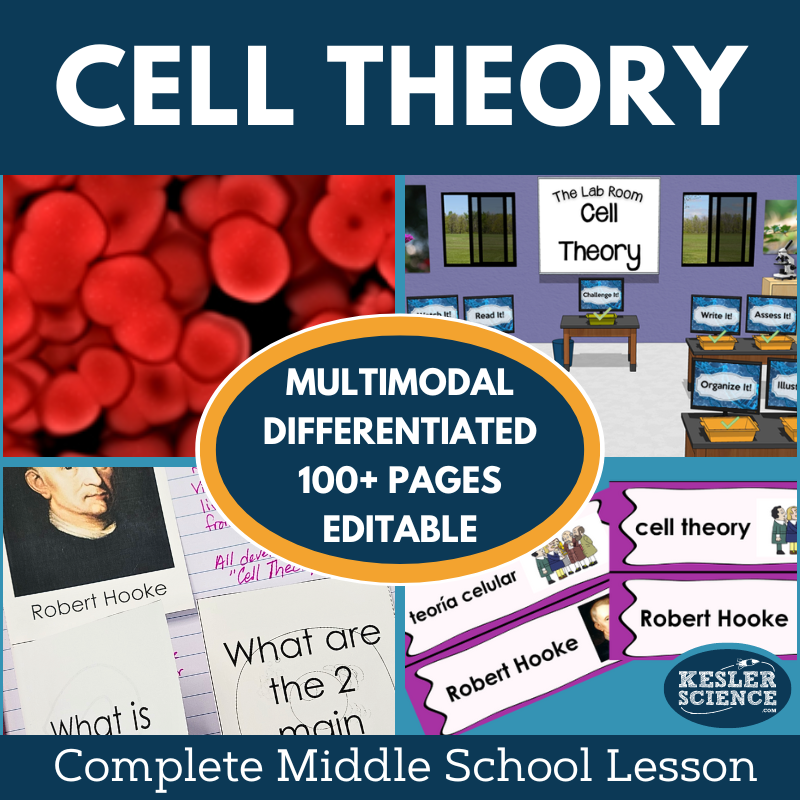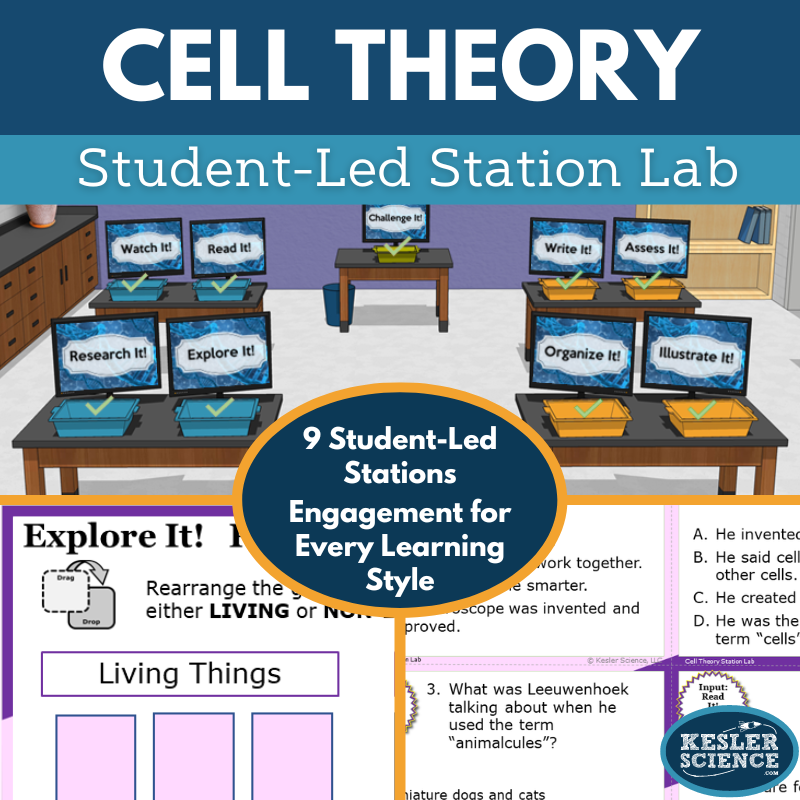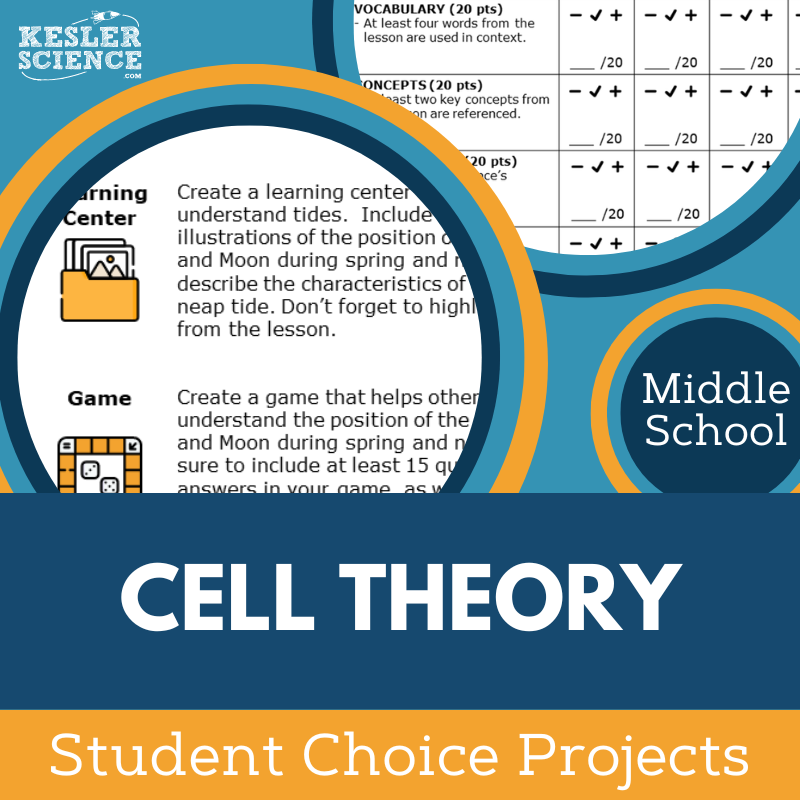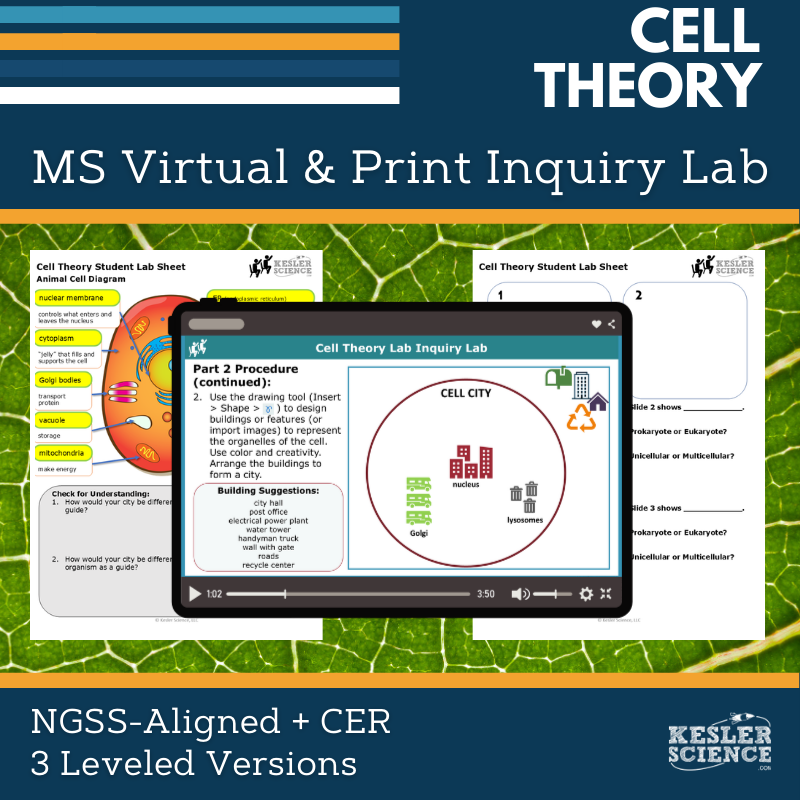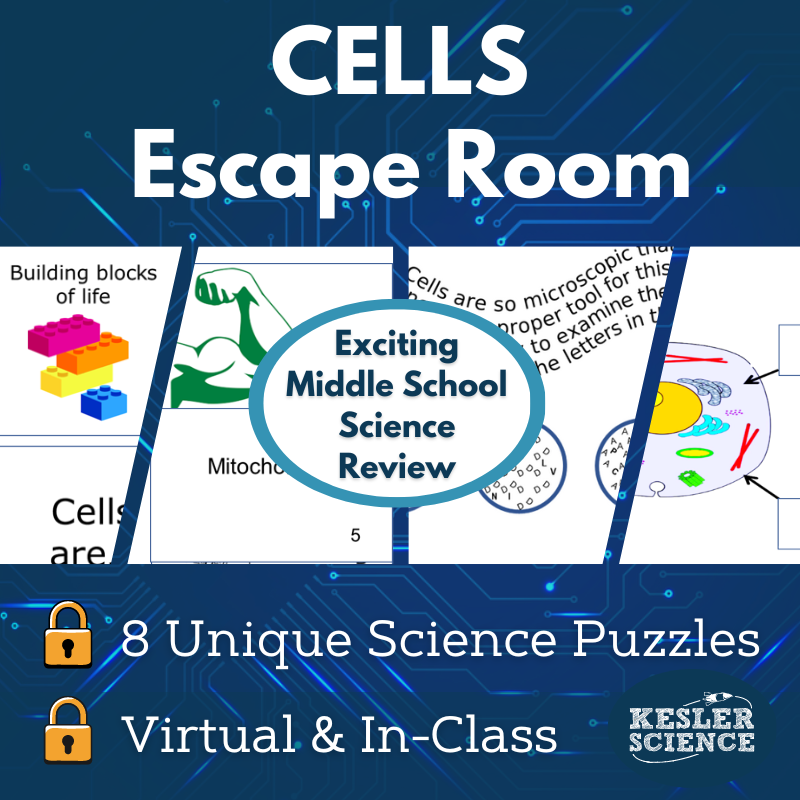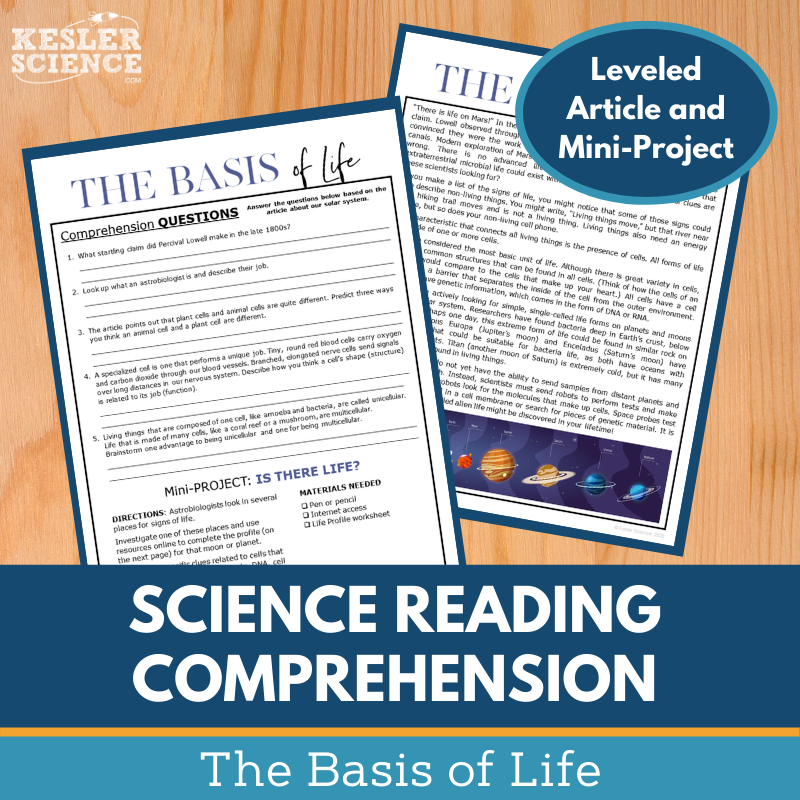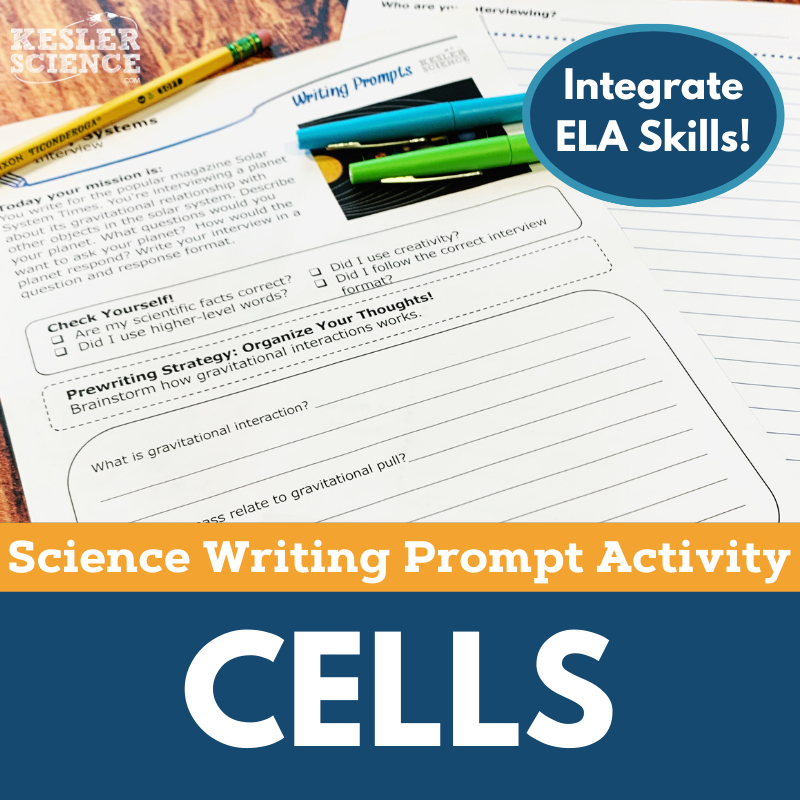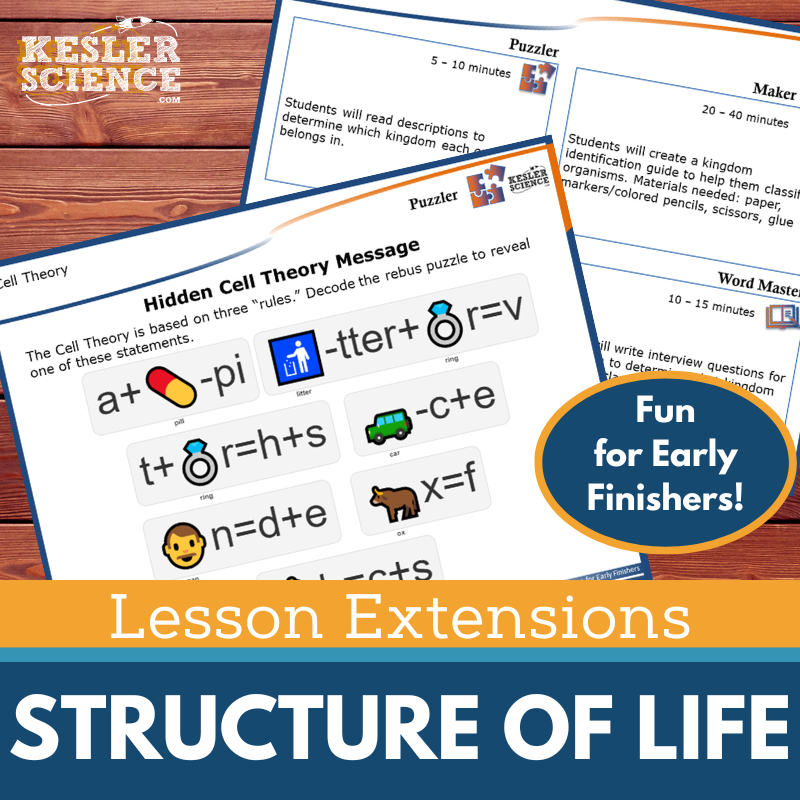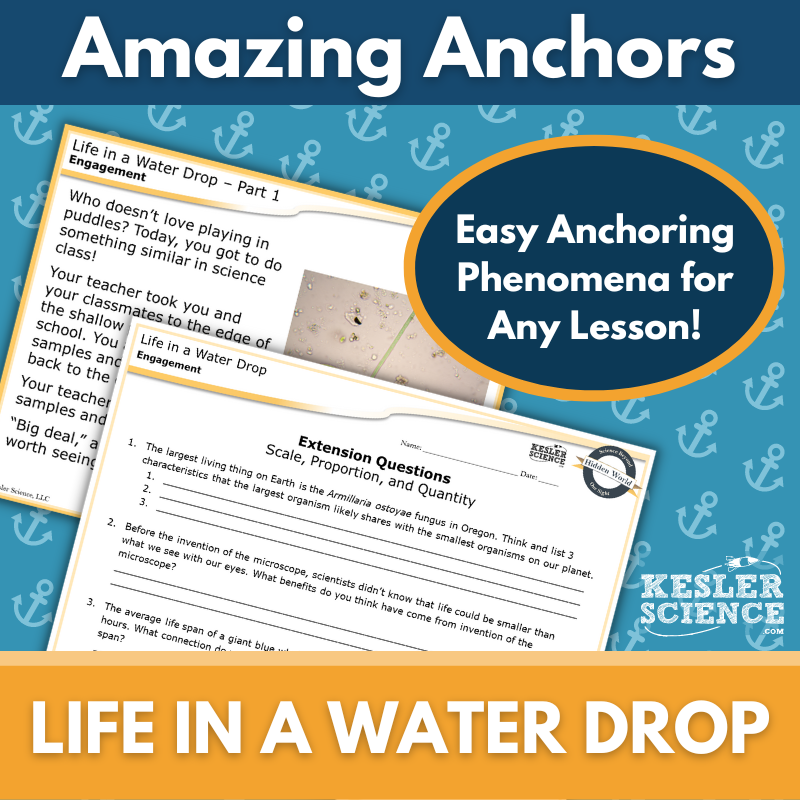Evidence of Living Things Activities for Middle School Science
This student-led Cell Theory 5E Lesson engages middle school students with hands-on activities, digital and printable resources, and differentiated instruction. The resources below will give students a comprehensive understanding of the evidence of living things. All of the following materials are also included in the Kesler Science Membership.
The Kesler Science Cell Theory 5E Lesson is a comprehensive, student-led unit designed for middle school classrooms. It includes editable presentations, worksheets, choice projects, and assessments, all requiring minimal prep. The lesson supports differentiated learning, multimodal instruction, and flexibility in digital and printable formats, with Spanish translations for key materials.
Aligned with NGSS standards, this unit follows the 5E Model: Engagement introduces objectives and class activities, Exploration features a nine-station lab with hands-on, reading, research, and video-based learning, and Explanation includes editable PowerPoints, interactive notebooks, and note-taking templates. Elaboration offers student-choice projects to extend learning, while Evaluation provides STAAR-aligned assessments and review worksheets.
The lesson is adaptable for virtual and in-person learning, ensuring accessibility for all students.
The Kesler Science Cell Theory 5E Lesson is a comprehensive, student-led unit designed for middle school classrooms. It includes editable presentations, worksheets, choice projects, and assessments, all requiring minimal prep. The lesson supports differentiated learning, multimodal instruction, and flexibility in digital and printable formats, with Spanish translations for key materials.
Aligned with NGSS standards, this unit follows the 5E Model: Engagement introduces objectives and class activities, Exploration features a nine-station lab with hands-on, reading, research, and video-based learning, and Explanation includes editable PowerPoints, interactive notebooks, and note-taking templates. Elaboration offers student-choice projects to extend learning, while Evaluation provides STAAR-aligned assessments and review worksheets.
The lesson is adaptable for virtual and in-person learning, ensuring accessibility for all students.
Engage your middle school students with this student-led station lab on cell theory, designed to foster independent learning. Through a structured yet flexible approach, students explore and compare the characteristics of cell theory while engaging in nine interactive stations featuring multimodal activities.
Students encounter new concepts through hands-on demonstrations, research tasks, reading passages, and video analysis. They demonstrate their understanding by organizing information, illustrating models, responding to prompts, and completing assessments. A challenge station offers extension activities for early finishers, and differentiated reading passages are available in both Spanish and English.
This modular, low-prep resource includes all necessary materials for in-class or virtual learning, making it an engaging and versatile addition to your science curriculum.
Engage your middle school students with this student-led station lab on cell theory, designed to foster independent learning. Through a structured yet flexible approach, students explore and compare the characteristics of cell theory while engaging in nine interactive stations featuring multimodal activities.
Students encounter new concepts through hands-on demonstrations, research tasks, reading passages, and video analysis. They demonstrate their understanding by organizing information, illustrating models, responding to prompts, and completing assessments. A challenge station offers extension activities for early finishers, and differentiated reading passages are available in both Spanish and English.
This modular, low-prep resource includes all necessary materials for in-class or virtual learning, making it an engaging and versatile addition to your science curriculum.
The Cell Theory Student Choice Projects lesson allows middle school students to select a project that aligns with their preferred output style. A project page outlines six student-led options plus a “design your own” project, all supported by an editable rubric for teacher, peer, or self-assessment.
These flexible, multimodal projects provide creative ways for students to demonstrate their understanding. Two versions of the project page support differentiation, with modified options for students needing remediation and challenge options for advanced learners. Teachers can adjust the rubric to fit grading needs.
The projects require standard classroom supplies like paper, markers, and scissors, with many options available for digital completion. Some crafting materials may be helpful for model-building activities.
The Cell Theory Student Choice Projects lesson allows middle school students to select a project that aligns with their preferred output style. A project page outlines six student-led options plus a “design your own” project, all supported by an editable rubric for teacher, peer, or self-assessment.
These flexible, multimodal projects provide creative ways for students to demonstrate their understanding. Two versions of the project page support differentiation, with modified options for students needing remediation and challenge options for advanced learners. Teachers can adjust the rubric to fit grading needs.
The projects require standard classroom supplies like paper, markers, and scissors, with many options available for digital completion. Some crafting materials may be helpful for model-building activities.
The Cell City Inquiry Lab aligns with NGSS MS-LS1-1, guiding students to investigate cell theory and compare organelles to city structures. This lab includes both digital and hands-on versions, each featuring comprehension questions, Claim-Evidence-Reasoning (C.E.R.) prompts, and a reflection section.
Students build a cell city, identifying organelle functions through an engaging analogy. The lab offers three differentiated levels: dependent (guided with inquiry questions), modified (structured with supports like sentence stems), and independent (student-led exploration).
The print version involves a hands-on experiment using index cards, colored pencils, cell organelle images, scissors, a microscope, and prepared slides of animal tissue, plant tissue, and unicellular organisms. The digital version is an interactive PowerPoint compatible with Google Slides, requiring no materials.
Teachers can customize editable PowerPoints, access teacher resource pages, answer keys, and multiple formats for maximum flexibility. This lab ensures multimodal learning, keeping middle school students engaged while supporting different learning needs.
The Cell City Inquiry Lab aligns with NGSS MS-LS1-1, guiding students to investigate cell theory and compare organelles to city structures. This lab includes both digital and hands-on versions, each featuring comprehension questions, Claim-Evidence-Reasoning (C.E.R.) prompts, and a reflection section.
Students build a cell city, identifying organelle functions through an engaging analogy. The lab offers three differentiated levels: dependent (guided with inquiry questions), modified (structured with supports like sentence stems), and independent (student-led exploration).
The print version involves a hands-on experiment using index cards, colored pencils, cell organelle images, scissors, a microscope, and prepared slides of animal tissue, plant tissue, and unicellular organisms. The digital version is an interactive PowerPoint compatible with Google Slides, requiring no materials.
Teachers can customize editable PowerPoints, access teacher resource pages, answer keys, and multiple formats for maximum flexibility. This lab ensures multimodal learning, keeping middle school students engaged while supporting different learning needs.
The Cells Escape Room is an engaging, interactive activity that allows students to demonstrate their understanding of cells and organelles in a fun and immersive way. Designed to align with TEKS, as well as NGSS, this escape room challenges students to differentiate between plant and animal cell organelles, compare their functions to organ systems, and recognize components of cell theory.
Teachers have full control over the eight independent puzzles, allowing customization based on class length and student needs. The escape room can be conducted using manila envelopes for an easy setup or with a lock-and-box system for a more authentic experience. Printable and digital formats are available, including a Single Student Digital Version in PowerPoint or Google Slides, and a printable version in PPT or PDF for home use.
The resource includes teacher directions, detailed answer keys, an editable teacher version, a digital answer sheet, a video challenge, and all necessary printable props. Additional features include reward templates, over 50 prize ideas, and 30 unique signs for post-activity photos. This engaging escape room will keep students excited and talking about their learning experience for weeks!
The Cells Escape Room is an engaging, interactive activity that allows students to demonstrate their understanding of cells and organelles in a fun and immersive way. Designed to align with TEKS, as well as NGSS, this escape room challenges students to differentiate between plant and animal cell organelles, compare their functions to organ systems, and recognize components of cell theory.
Teachers have full control over the eight independent puzzles, allowing customization based on class length and student needs. The escape room can be conducted using manila envelopes for an easy setup or with a lock-and-box system for a more authentic experience. Printable and digital formats are available, including a Single Student Digital Version in PowerPoint or Google Slides, and a printable version in PPT or PDF for home use.
The resource includes teacher directions, detailed answer keys, an editable teacher version, a digital answer sheet, a video challenge, and all necessary printable props. Additional features include reward templates, over 50 prize ideas, and 30 unique signs for post-activity photos. This engaging escape room will keep students excited and talking about their learning experience for weeks!
This Science Reading Comprehension Passage helps students explore how living things are made of cells by reading a nonfiction article about life in our solar system. Designed for middle school, the leveled passage supports science literacy and reading comprehension.
The resource includes two leveled articles (Lexile 1100-1300), five to seven comprehension questions, a hands-on mini-project, and a Cornell notes template. It features engaging, printable graphics and is compatible with virtual learning platforms like Google Classroom, MS Teams, Schoology, and Canvas.
Perfect for sub plans, extra credit, ISS, or whole-class instruction, this resource fosters critical thinking, classroom discussions, and textual analysis while reinforcing key life science concepts.
This Science Reading Comprehension Passage helps students explore how living things are made of cells by reading a nonfiction article about life in our solar system. Designed for middle school, the leveled passage supports science literacy and reading comprehension.
The resource includes two leveled articles (Lexile 1100-1300), five to seven comprehension questions, a hands-on mini-project, and a Cornell notes template. It features engaging, printable graphics and is compatible with virtual learning platforms like Google Classroom, MS Teams, Schoology, and Canvas.
Perfect for sub plans, extra credit, ISS, or whole-class instruction, this resource fosters critical thinking, classroom discussions, and textual analysis while reinforcing key life science concepts.
The Cells Science Writing Prompt Activity engages middle school students in a creative and interactive exercise to test their knowledge of life science. Using a print advertisement format, this activity enhances science reasoning and writing skills while supporting both in-person and virtual learning. Aligned with MS-LS1-1, it helps students investigate the concept that all living things are made of cells.
This resource includes teacher directions with an answer guide, project ideas, and rubrics, as well as projection and print versions for flexibility. Students receive full-sized and half-sheet handouts with prompts, self-checks, and pre-writing strategies. A digital PowerPoint version, compatible with Google Slides, allows for virtual engagement.
Ideal for cross-curricular activities, pre-test assessments, student choice projects, early finisher tasks, extra credit, make-up work, TELPAS samples, or differentiation, this writing prompt fosters creativity and scientific literacy. It can be displayed on bulletin boards or compiled into student anthologies. Designed for review, it assumes students have prior knowledge or access to research materials.
The Cells Science Writing Prompt Activity engages middle school students in a creative and interactive exercise to test their knowledge of life science. Using a print advertisement format, this activity enhances science reasoning and writing skills while supporting both in-person and virtual learning. Aligned with MS-LS1-1, it helps students investigate the concept that all living things are made of cells.
This resource includes teacher directions with an answer guide, project ideas, and rubrics, as well as projection and print versions for flexibility. Students receive full-sized and half-sheet handouts with prompts, self-checks, and pre-writing strategies. A digital PowerPoint version, compatible with Google Slides, allows for virtual engagement.
Ideal for cross-curricular activities, pre-test assessments, student choice projects, early finisher tasks, extra credit, make-up work, TELPAS samples, or differentiation, this writing prompt fosters creativity and scientific literacy. It can be displayed on bulletin boards or compiled into student anthologies. Designed for review, it assumes students have prior knowledge or access to research materials.
Lesson Extensions provide engaging, student-choice activities designed to challenge early finishers and deepen their understanding of life science concepts. These activities help reinforce critical thinking, prevent distractions, and offer rigorous yet enjoyable learning opportunities that align with NGSS and TEKS standards.
Each extension includes four interactive components: Puzzler for problem-solving, Maker Space for hands-on STEAM activities, Tech Connection for digital demonstrations, and Word Master for creative writing. With teacher directions, answer keys, and both print and projection versions, these extensions are perfect for lesson wrap-ups, enrichment, or independent challenges.
Covering topics such as artificial selection, body systems, cell structures and functions, genetic variations, heredity, natural selection, and levels of organization, these activities provide high-level engagement for students ready to explore life science more deeply.
Lesson Extensions provide engaging, student-choice activities designed to challenge early finishers and deepen their understanding of life science concepts. These activities help reinforce critical thinking, prevent distractions, and offer rigorous yet enjoyable learning opportunities that align with NGSS and TEKS standards.
Each extension includes four interactive components: Puzzler for problem-solving, Maker Space for hands-on STEAM activities, Tech Connection for digital demonstrations, and Word Master for creative writing. With teacher directions, answer keys, and both print and projection versions, these extensions are perfect for lesson wrap-ups, enrichment, or independent challenges.
Covering topics such as artificial selection, body systems, cell structures and functions, genetic variations, heredity, natural selection, and levels of organization, these activities provide high-level engagement for students ready to explore life science more deeply.
This Amazing Anchors Phenomenon Lesson engages students in exploring single- and multi-cellular organisms through real-world connections. It begins with an introductory reading on examining pond water under a microscope, accompanied by comprehension and extension questions to build curiosity. An explanatory reading follows, breaking down the science of living things and their cells in an accessible way, with additional questions for reinforcement.
Aligned with NGSS standard LS1-1, this no-prep resource includes teacher directions, answer keys, projection slides, and both print and digital formats for Google Classroom and other LMS platforms. A differentiated version provides sentence starters for student support. Designed to bookend a lesson, these engaging readings enhance learning and fit seamlessly into the Engagement and Elaborate segments of 5E lessons.
This Amazing Anchors Phenomenon Lesson engages students in exploring single- and multi-cellular organisms through real-world connections. It begins with an introductory reading on examining pond water under a microscope, accompanied by comprehension and extension questions to build curiosity. An explanatory reading follows, breaking down the science of living things and their cells in an accessible way, with additional questions for reinforcement.
Aligned with NGSS standard LS1-1, this no-prep resource includes teacher directions, answer keys, projection slides, and both print and digital formats for Google Classroom and other LMS platforms. A differentiated version provides sentence starters for student support. Designed to bookend a lesson, these engaging readings enhance learning and fit seamlessly into the Engagement and Elaborate segments of 5E lessons.
Year-Round Resources
These year-round activities will increase your students' understanding of many middle school science topics. All of these activities are also included in the Kesler Science Membership.
Visual Data & Graphing
You're not alone if your students struggle with understanding graphs, charts, and tables. It's a skill that takes an enormous amount of practice. This resource will help students build a strong foundation in analyzing data and creating their own data visualizations.
Bell Ringers and Warm-Ups
These middle school science bell ringers are an excellent way to engage your students as soon as they walk into your classroom. This comprehensive FULL YEAR resource includes everything you need to start off each science class with an interesting warm-up activity.
Review Board Games
Each game board has been carefully designed to keep students engaged. There are 10 different action spaces on each board and dozens of question cards. All of the actions are related to science concepts and keep the students motivated throughout the game.
Each game is ready to play. Simply print out the board and the cards and let the students enjoy reviewing nine different units.
Essential Questions and Standards
Below are the essential questions and standards associated with the lessons and activities included in the evidence of living things unit. This topic is only one of more than 100 middle school science topics included in the Kesler Science Membership.
-
What is the cell theory?
-
What are similar functions of all cells?
-
NGSS - MS-LS1-1 Evidence of Living Things
Kesler Science Membership
Imagine never having to search for another middle school science lesson again. The membership gives you access to ALL of the Kesler Science products in one place (Yes, including everything above).
Say goodbye to long hours of lesson prep.

